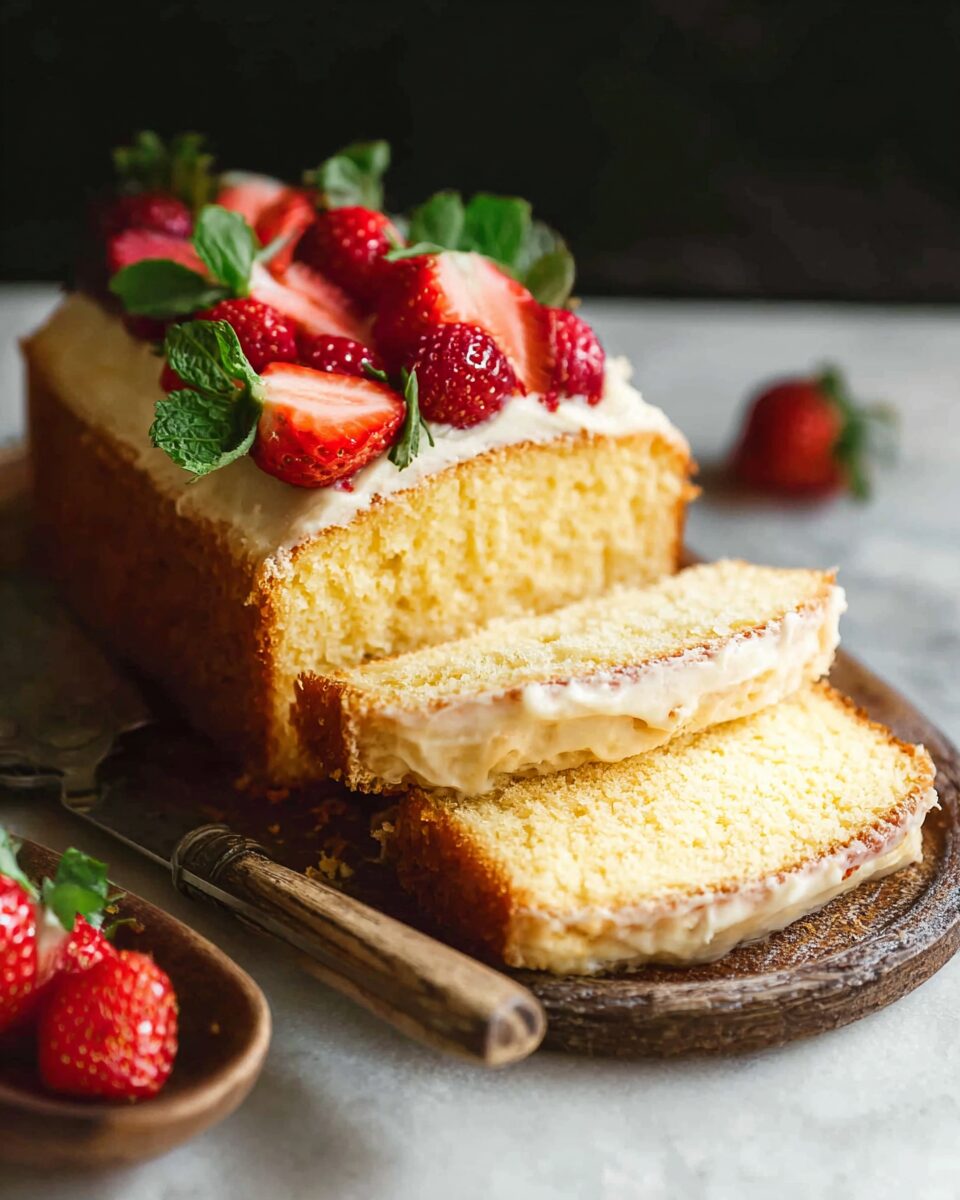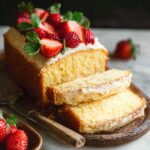Light, airy, and delicately sweet, this Vanilla Sponge Cake is a timeless classic that will melt in your mouth. Whether you’re hosting a special event or simply indulging in a sweet treat, this fluffy cake makes the perfect dessert for any occasion. It’s simple yet elegant, with a moist texture that pairs wonderfully with a dusting of powdered sugar or a dollop of whipped cream.
The beauty of this cake lies in its simplicity. With just a few basic ingredients, you can create a light and fluffy treat that is perfect for layering with fresh fruits or filling with jam for a delightful twist. This versatile recipe can be customized to fit any occasion, whether it’s a casual afternoon tea or a birthday celebration. Get ready to bake up some joy with this delicious Vanilla Sponge Cake!
Full Recipe:
-
1 cup (125g) plain flour
-
1 cup (200g) sugar
-
6 large eggs, at room temperature
-
1/4 cup (60ml) milk
-
1/4 cup (60g) unsalted butter, melted
-
1 tsp vanilla extract
-
1 tsp baking powder
-
1/4 tsp salt
-
Powdered sugar for dusting (optional)
Directions:
-
Preheat the oven to 350°F (175°C). Grease and line a round 8-inch cake pan.
-
In a bowl, sift the flour and baking powder together. Set aside.
-
In a large mixing bowl, whisk the eggs and sugar together until thick and pale, about 5 minutes.
-
Gently fold in the sifted flour mixture, a little at a time, being careful not to deflate the air in the egg mixture.
-
Heat the milk and melted butter together in a small saucepan until warm, then add the vanilla extract.
-
Slowly pour the milk mixture into the batter, folding gently until fully combined.
-
Pour the batter into the prepared cake pan and smooth the top.
-
Bake for 20-25 minutes, or until the cake is golden and a skewer inserted comes out clean.
-
Allow the cake to cool in the pan for 10 minutes before transferring to a wire rack to cool completely.
-
Dust with powdered sugar before serving if desired.
Prep Time: 15 minutes | Cooking Time: 25 minutes | Total Time: 40 minutes
Kcal: 190 kcal per serving | Servings: 8 servings
The Charm of a Classic Vanilla Sponge Cake
Vanilla sponge cake is one of those timeless desserts that never go out of style. Known for its light and airy texture, this cake serves as the foundation for countless variations—from layered birthday cakes to elegant wedding centerpieces. Despite its humble ingredients, the sponge cake holds a special place in the world of baking, admired for its simplicity, versatility, and universally loved flavor. Whether you’re a beginner or a seasoned baker, mastering this recipe opens up a world of possibilities.
The History Behind the Sponge Cake
The sponge cake has deep roots in culinary history, dating back to at least the 18th century. One of the earliest known sponge cakes originated in Europe, where it was prized for its featherlight texture and absence of butter. Unlike denser cakes that relied on chemical leavening, sponge cakes achieved their airy structure from whipped eggs, a revolutionary technique at the time. Over the centuries, regional variations developed—some added fat like butter or oil, while others introduced flour alternatives or different flavorings. The version we know and love today—a moist, vanilla-scented sponge with a delicate crumb—has become a baking staple in homes and professional kitchens alike.
The Science of a Perfect Sponge
What makes a sponge cake so light and fluffy? It’s all about the eggs. The technique of whipping eggs with sugar until they triple in volume creates a foam that traps air. When baked, that air expands and gives the cake its signature rise. The folding process is also crucial—too rough and the air escapes; too timid and the ingredients don’t combine properly. Warm milk and melted butter, added gently at the end, ensure a moist yet soft crumb without weighing the batter down. Baking a perfect sponge cake is as much about technique as it is about ingredients, which is why it’s considered a rite of passage for many bakers.
Why Vanilla Is the Star
Vanilla is often underestimated as a flavor because of its ubiquity, but in a vanilla sponge cake, it truly shines. It adds a warm, sweet aroma and depth that elevates the simple cake into something elegant. The use of pure vanilla extract—not imitation—is what makes a significant difference. It balances the sugar and enhances the natural flavor of the eggs and butter, contributing to the cake’s rich yet subtle taste. In this cake, vanilla isn’t just a background note; it’s the heart of the dessert.
The Versatility of Vanilla Sponge Cake
One of the best things about a vanilla sponge cake is how adaptable it is. Want a classic strawberry shortcake? Use sponge layers. Planning a birthday celebration? Stack and fill with buttercream or ganache. Looking for a light afternoon treat? A simple dusting of powdered sugar and a cup of tea is all you need. You can serve it plain, drizzle it with syrup, frost it, or layer it with fruit and whipped cream. The sponge cake acts like a blank canvas for any creative or seasonal twist you want to introduce.
Ideal Occasions for Serving
Vanilla sponge cake is appropriate for nearly every occasion. It’s refined enough for formal events and simple enough for everyday desserts. It’s especially ideal for birthdays, afternoon teas, bridal showers, and small celebrations at home. You can easily dress it up with decorations or keep it minimal and rustic. Its light texture also makes it a favorite choice for summer desserts, especially when paired with fresh berries or a lemon glaze.
Storage and Make-Ahead Tips
One of the benefits of this cake is its ability to hold up well over time. Once completely cooled, it can be stored in an airtight container at room temperature for up to 3 days. If you plan to frost it later, you can wrap the unfrosted layers tightly in plastic wrap and refrigerate for up to 5 days or freeze for up to 2 months. Thaw overnight in the fridge before decorating or serving. These qualities make it perfect for make-ahead party prep or meal planning.
Pairing Suggestions
While this cake is delightful on its own, it also pairs beautifully with a variety of flavors and textures. Fresh fruits like strawberries, blueberries, and peaches add brightness and contrast. Whipped cream and mascarpone bring a creamy richness. For something indulgent, try layering it with chocolate ganache or pastry cream. You could even slice it into cubes for trifles or parfaits. Beverage-wise, it goes wonderfully with black tea, espresso, or a glass of dessert wine.
Tips for Consistent Success
If you’re new to sponge cakes, here are a few essential tips:
-
Use room temperature eggs for maximum volume.
-
Whip the eggs and sugar until the batter leaves thick ribbons when lifted.
-
Sift the dry ingredients to avoid clumps and encourage even mixing.
-
Fold gently but thoroughly—this part determines your final texture.
-
Don’t open the oven door too early, or the cake may collapse.
-
Let the cake cool in the pan before transferring to a wire rack to avoid breakage.
Common Mistakes to Avoid
Even though sponge cakes require few ingredients, there’s little margin for error. Overmixing the batter after adding flour is a common mistake that deflates the foam and creates a dense cake. Another issue is baking at the wrong temperature—too hot, and the cake browns too quickly; too cool, and it won’t rise properly. Skipping the step of sifting flour can also result in uneven texture or pockets of dry flour in the final product. Finally, using cold eggs or butter can throw off the chemistry of the batter, so always follow temperature recommendations closely.
Customizing the Recipe
Once you’ve mastered the basic vanilla sponge cake, the door is open to countless variations. You can infuse the milk with herbs like lavender or chamomile for a floral twist, or swap out vanilla for almond or citrus extracts. Add cocoa powder for a chocolate version or fold in ground nuts for extra texture. Many bakers enjoy brushing the cake with flavored syrups or liqueurs to add moisture and complexity. The adaptability of this sponge cake is truly what sets it apart from other desserts.
Why This Recipe Belongs in Every Baker’s Repertoire
This vanilla sponge cake isn’t just another dessert—it’s a cornerstone recipe that supports your entire baking journey. It teaches you about the power of technique, the role of each ingredient, and the importance of timing and texture. Once you’ve mastered it, you can build on it to create elaborate celebration cakes, delicate layered desserts, or quick everyday treats. It’s a foundational recipe that never fails to impress and is always welcome on any table.
Conclusion
The vanilla sponge cake is a quiet superstar in the world of baking—understated yet powerful in its simplicity. Its ethereal texture, delicate crumb, and subtle vanilla essence make it endlessly appealing. Whether you serve it plain with tea or transform it into a layered showstopper, this cake consistently delivers. It embodies the magic of baking: turning a few simple ingredients into something truly special. For home bakers and pastry professionals alike, a reliable sponge cake recipe is not just a tool—it’s a treasure.





